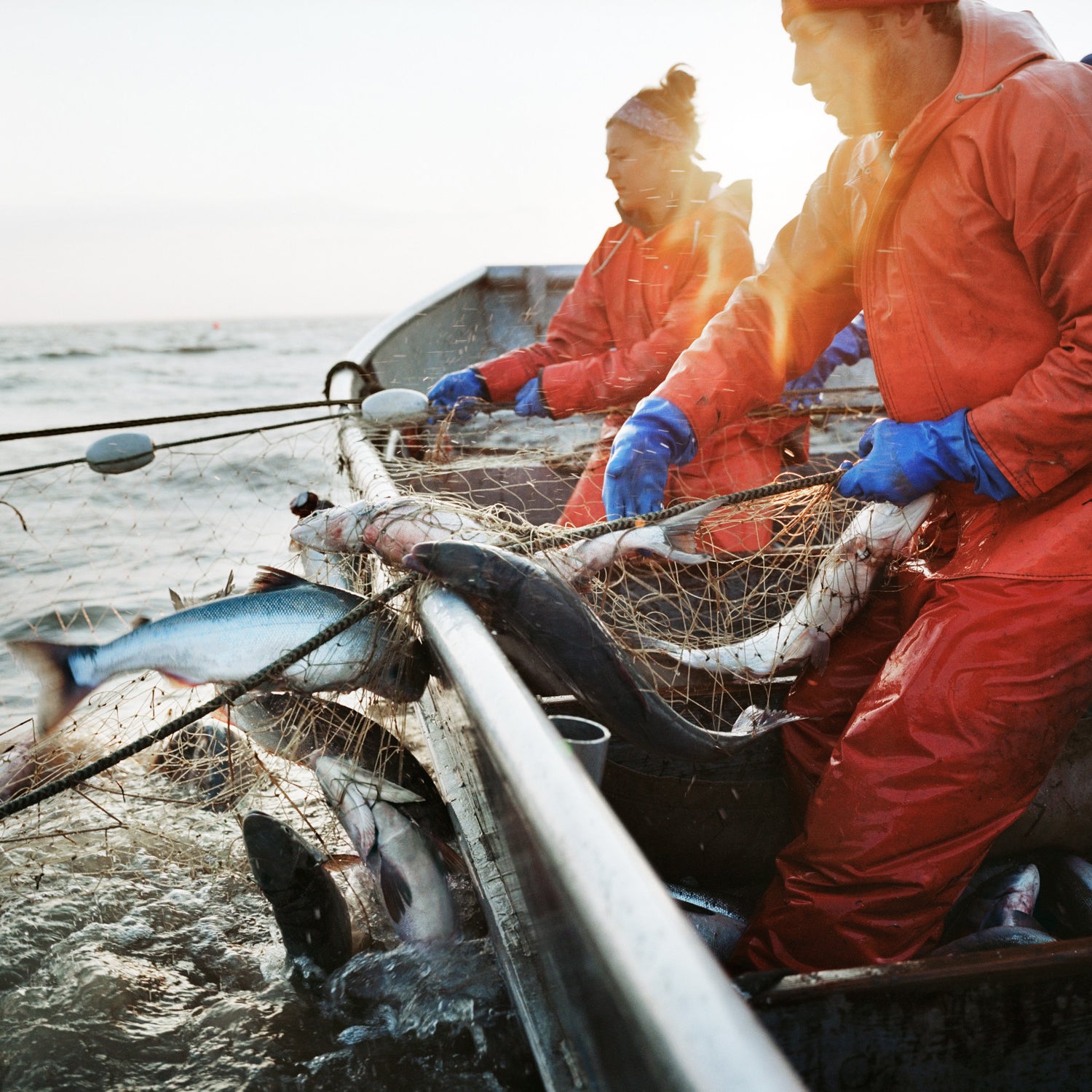When President Obama that Alaska’s Bristol Bay region would be off limits to future offshore oil and gas exploration, the news was greeted with cheers from the fishermen, Native groups, and conservationists who have spent years fighting to protect the Bay and its legendary salmon run from development. Surprisingly, the anti-drilling measure received little criticism in the oil-reliant state.
The president, , seemed upbeat as he issued an indefinite extension of temporary protections he set in 2010 for what’s known as the North Aleutian Basin planning region. The area, which he called “one of America’s greatest natural resources,” is a 32.5 million-acre expanse of federal waters in the Bering Sea north of the Alaska Peninsula. The announcement brought an end to the contentious, decades-long debate over whether to allow the sale of offshore oil and gas leases there.
“Bristol Bay has supported Native Americans in the Alaska region for centuries,” the president said as the video cut away from the staid, staged formality of the Oval Office to images of the benign chaos of the salmon fishery. “It supports about $2 billion in commercial fishing industry, supplies America with 40 percent of its wild-caught seafood. It is a beautiful natural wonder, and it’s something that’s too precious for us to just be putting out to the highest bidder.”
The move was a strong statement in support of protecting Bristol Bay and its legendary salmon run. It was also the only direct action available to the president. But, happy as they were with the decision, the bay’s advocates were quick to point out that the fight to protect the bay is not over.��Large-scale drilling was a threat, but always more of a speculative one. The more immediately pressing issue, and the one that’s made far more headlines, is the so-called Pebble Mine.
��
About a hundred miles upstream from the bay, an international consortium of mining companies has, for the past decade, been conducting exploratory drilling on the Pebble deposit, laying the groundwork for a massive copper, gold and molybdenum mine worth potentially hundreds of billions of dollars. The mine would sit near the headwaters of two of the major salmon rivers that feed the bay, amid pristine spawning habitat. , the group developing the site, insists it can be done safely. But opponents fear it could do great harm to the salmon run, with one opponent of the mine going so far as to describe it as an “existential threat.” Pebble has attracted the lion’s share of activists’ attention and the resulting media coverage. But though drilling remained in the background, its opponents benefited from the higher profile that the Pebble fight brought.
“If you want to protect the salmon watershed, you have to protect both the headwaters and the deep ocean, because the salmon need both,” said Dorothy Childers, (AMCC), one of groups leading the charge against drilling. “It became really clear that the two issues,” mining and drilling, “were linked in terms of salmon, so it became more of one story to tell.”
Protection is a welcome step after decades of uncertainty over the region’s drilling prospects. First proposed in the 1970s, oil and gas leases were sold by the Reagan Administration in the 1980s, then bought back at taxpayer expense during the Clinton Administration in the 1990s. The Bush Administration put them back on the leasing schedule in the 2000s, a move President Obama reversed in 2010.
One major factor in creating a national debate around Bristol Bay was the EPA’s decision in 2010, at the invitation of a number of Bristol Bay Native groups, to conduct a comprehensive study of the potential effects of mining on the bay’s watershed. Earlier this year, the EPA announced its intention to propose protections for the bay under the Clean Water Act. Soon after, Pebble sued the agency. In late November, a federal judge in Anchorage issued a temporary injunction that halted the EPA’s work on Pebble. In doing so, the judge stymied the federal government’s only avenue for blocking the development of a mine that, its supporters are quick to note, would operate on state-owned lands designated for mineral exploration.
The EPA’s approach to Pebble colors every conversation about Bristol Bay’s future these days. To those who wonder how the president’s oil and gas announcement affects the mining proposal, the answer is simple: Not much. According to Pebble’s spokesman, Sean Magee, “This is not a policy announcement that will affect us in any way.” Still, he said, the timing surprised Pebble’s leaders. (The EPA is currently prohibited from working on, or even talking about, Pebble due to the preliminary injunction issued in November, and that won’t change any time soon.)
Indeed, everyone I spoke with noted the curious timing of the president’s decision. The simplest explanation is that the president wanted to shield Bristol Bay, and has the authority to do so under . It’s a power that’s been used before—most notably by President Eisenhower, who used it to protect waters off the Florida Keys in 1960.
The decision was made easier by the fact that there is not currently any industrial entity pursuing development of these particular oil and gas resources. Plus, the move does obvious good, protecting not just Bristol Bay’s salmon, but the rest of the Bering Sea fisheries—king crab, herring, halibut, groundfish—which are economic engines, ecological marvels, cultural and dietary pillars for Alaskan Natives, and a bedrock component of the Alaskan self-image.
Even people normally opposed to any federal meddling in Alaskan matters found little to attack here. “Given the lack of interest by industry and the public divide over allowing oil and gas exploration in this area, I am not objecting to this decision at this time,” said Sen. Lisa Murkowski (R-AK), in a surprisingly neutral written statement. “I think we all recognize that these are some of our state’s richest fishing waters.”��
Murkowski also called attention to the president’s timing. “What I do not understand is why this decision could not be made within the context of the administration’s upcoming plan for offshore leasing—or at least announced at the same time.”
Even people normally opposed to any federal meddling in Alaskan matters found little to attack here.
The Administration is in the early stages of planning the next five-year oil and gas lease plan, and it could have waited to announce the Bristol Bay protection with the new plan. Childers, of the conservation council, speculates that the feds may have thought it better to “take Bristol Bay off the table before they put together their draft leasing plan” to avoid debate on the issue and remove any uncertainty about this aspect of the region’s future.
“This has been a 25-year battle for us, having one President put leases out for bid, another President pull them, governors support them, then not, so it’s a relief,” said Robin Samuelsen, a Native leader, long-time commercial fisherman, and Chairman of the . “Now we’ve got to turn our attention even more strongly towards the Pebble mine.”
And while the EPA’s work on Pebble is paused, the president’s highly visible announcement—a snappy video featuring an animated commander in chief, rather than a mere press release—seems like a calculated bit of strategy. Coming so closely on the heels of the preliminary injunction against the EPA, it seems like a reaffirmation of the Administration’s commitment to protecting Bristol Bay from all industrial development, not just drilling. It is, some of the mine’s opponents hope, something of a warming to the Pebble partnership, as well as an assurance to the beleaguered anti-Pebble brigades, that the Administration will remain committed to this issue for the remainder of the president’s term.��
“It wouldn’t make any sense to protect one end of the watershed without the other,” Childers said. “You wouldn’t be accomplishing the task.”
Read more at the and be sure to check out Tim Sohn’s ���ϳԹ��� feature on the salmon fishery and the Pebble controversy, “Gold Fish.”


